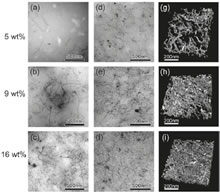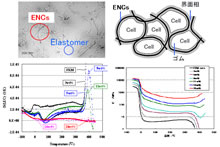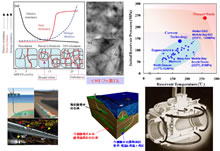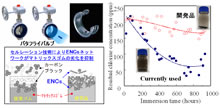Research
The Regional Distinguished Laboratory performs theoretical research on cellulation nanoalloys created using innovative exotic nanocarbons (ENCs). In addition, we evaluate the basic properties of our new materials, their durability, their applications, their production processes and their suitability for production. For the materials that meet our criteria, we evaluate products and do marketing.
Through the ENC research and development consortium and the open innovation philosophy of its member companies, we can develop our materials, evaluate their suitability, do marketing and bring them to a wide range of markets quickly.
Research and Development of Innovative ENC Alloys
 Control of nanospaces using ENCs
Control of nanospaces using ENCs
We perform basic research and theoretical elucidation as well as development of innovative materials. Our main research topics are as follows.
(1) Research and Development of Aluminum Alloys: We are aiming to greatly improve the workability and differentiate our materials from existing ones by improving their physical properties and adjusting their balance of tensile strength, proof stress and elongation.
- Reference: T.Noguchi, A.Magario,S.Fukazawa,S.Shimizu, J.Beppu, M.Seki, “CarbonNanotube/Aluminum Composites with Uniform Dispersion”, Materials Transactions, 45 , p.602-604 (2004)
(2) Research and Development of Resin Alloys: We are studying the suitability of olefin resins for automotive parts and developing new materials with improved tensile strength, yield strength and elastic modulus. We are also developing new materials using fluorine resins.
Applied Development of ENC Elastomer Alloys
 TEM image, model and innovative performance of ENC elastomer alloy/cellulation composites
TEM image, model and innovative performance of ENC elastomer alloy/cellulation composites
In the area of elastomer alloy research, to provide a base for implementation we are doing basic research and theoretical elucidation as well as research and development and product evaluation (endurance tests on actual machines) of implementable materials in addition to marketing. Thus, we perform all the steps of the Science->Technology->Engineering->Industry process in parallel. Our main research topics are as follows.
(1) Fundamental Material Research I: Elucidation of Cell/Tie Theory of ENC composite elastomers, new ENC cellulation research (development of new materials), fusion with new polymers.
Fundamental Material Research II: Joint research on the development and implementation of graphene ENC nanoalloys with the Terrones Group.
Fundamental Material Research III: Joint research on the creation of new materials with the Endo Group, Kaneko Group and Ajayan Group.
(2) Implementation of a Super Seal (Sealant): Development of implementable materials, evaluation of suitability and marketing. The main applications are: equipment to probe underground resources, plumbing equipment and fuel cells.
(3) Development of compounds for tires
(4) Development of new seismic isolation rubber
References:
(1) Noguchi,T., Inukai,S., Ueki,H.,Magario,A, Endo,M.: SAE Tech. Pap. Ser. (Soc. Automot. Eng), Page.5P(2009)
(2) Fei Deng, Masaei Ito, Toru Noguchi, L.F.Wang, Hiroyuki Ueki, Ken-ichi Niihara, Y.A.Kim, Morinobu Endo, Q.S.Zheng, “Elucidation of Reinforcing Mechanism in Carbon Nanotube /Rubber Nanocomposite”, ACS nano, 5(2011)3858-3866, (10.1021/nn200201u)
ENC Elastomer Alloy (Sealant) Implementation Achievements
 Underground resource probe: High performance seal material that has a previously unattainable durability of 260C and 300MPa
Underground resource probe: High performance seal material that has a previously unattainable durability of 260C and 300MPa
 Fluid control valve: Seal material that improves the performance of both the physical characteristics (abrasive resistance) and the chemical characteristics (chemical resistance)
Fluid control valve: Seal material that improves the performance of both the physical characteristics (abrasive resistance) and the chemical characteristics (chemical resistance)
(1) Development of static seals for underground resource probes
We succeeded in developing a high performance rubber seal that has an previously unattainable durability of 260C and 300MPa made by controlled CNT cellulation of the surface structure. This material is a super seal that performs in actual severe conditions (high and low temperatures, gas and liquid environments) found in an oil well. This new material has been tested in over 10 overseas ocean floor oil fields and was able to achieve the desired performance, which was impossible with existing seals. These achievements greatly alleviate oil and energy problems. For Japan, which has few oil resources, contributions to oil drilling technology contributes to the supply of resources. Currently, static seals that perform at 260C exist, but in environments such as ocean floor oil fields with low temperatures, gas and acid and alkaline and H2S liquids, a sufficient seal could not be obtained. This in turn leads to damage to oil probe and production equipment. Thus seal performance has been a problem. With the introduction of our new high performance rubber seals that can be used in high and low temperatures and high pressure environments, the amount of oil in reserves that can be extracted could be doubled.
Reference
M.Endo, T.Noguchi, M.Ito, K.Takeuchi, T.Hayashi, Y.A.Kim, T.Wanibuchi, H.Jinnai, M.Terrones, and M.S.Dresselhaus, “Extreme-Performance Rubber Nanocomposites for probing and Excavating Deep Oil Resources Using Multi-Walled Carbon Nanotubes”, Advanced Functional Materials 18, 3403(2008)
(2) Development of seals for fluid control butterfly valves
It was previously thought that the chemical and physical properties of elastomers were antinomical. However, we discovered that the performance of both the chemical and physical properties of our ENC composite cellulation elastomers could be greatly improved. Specifically, improvement in the elastomer's durability (tear strength) and stiffness could be obtained in addition to improvements in chemical resistance (chlorine resistance) and oil resistance, which was impossible with existing materials. Currently, we theorize that through the use of exotic nanocarbon cellulation technology, strong matrix retention (physical effect) and MWCNT/elastomer interface effects (chemical effect) allow both strengthening and a reduction in degradation to be obtained simultaneously, so we are working to elucidate this mechanism and to evaluate implementations. By applying these research results, it will be possible to greatly improve the durability and chemical resistance of the final product.
Reference
M. Endo; K.Takeuchi; T.Noguchi; Y. Asano; Y. A.Kim; T. Hayashi; H. Ueki; S.Iinou. "High Performance Rubber Sealant for Preventing Water Leaks" ACS, Ind. Eng.
Chem. Res., 2010, 49 (20), 9798.




 noguti
noguti
